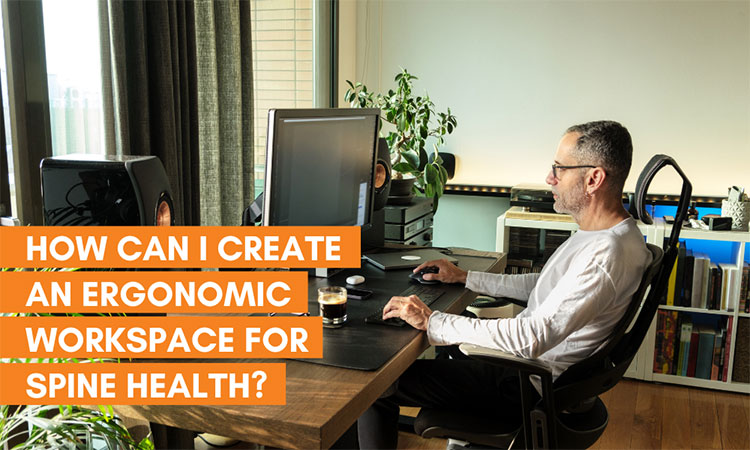Request Appointment
Enter your details and we will be in touch with you shortly;
Or call
8655885566
between 8 am and 8 pm.


COVID-19 drastically changed people’s outlook towards life. People have become more focused on their career and working either from home or the office and making efforts to stay fit. However, one thing that has remained constant all these times is ‘sitting on a desk for hours with a poor posture’. If you ask yourself about the challenges you face during office time, the most sought-after issues will be – wrist pain, back and neck issues, hip soreness, and even headaches.
For the unversed, these are all interconnected to poor spine care. If left unchecked, this can deteriorate spine health leading to chronic conditions such as bulging disc, herniated disk, etc, and might even require surgery to treat it. However, altering workspace ergonomics can help live a healthy and sustained back pain-free life ahead. Let’s see how it will work out for you.
Setting up an ergonomic workspace isn’t just about sitting upright and getting the work done, it’s more than that. According to the experts, head, arms, back, and movements are four key fundamentals that need alteration for preventing back pain. Let’s see how you can create an ergonomic workspace using the tips below.
As the spine runs right from the base of the skull to the sacral portion, the head is a key part of the structure that requires utmost care. The thing is, the farther you slouch your head, the more weight is added to the spine as it tends to move out of its neutral cervical curve. Statistically, moving 15° forward adds about 10 to 24 lbs of weight which is probably what’s triggering the excruciating neck pain and related headache. It is crucial to keep the screen at eye level so that you can position your head neutrally. You can use props to adjust the height of the screen until you get to a sweet spot.
Next in line are your arms. As per spine health 101, it’s crucial to keep the shoulders in a neural resting position rather than slouching them. The elbows should be bent at 90° and the wrist should be on the desk (or keyboard) in a neutral position as well. What this position does is, it takes away the excess pressure your arms might be subjected to when you sit on the desk with the usual poor posture. In fact, you can go for wireless keyboards to cut away from the cords and keep a sufficient distance between yourself and the computer screen.
Undoubtedly the most cursed part of working in an office (or at home) on an office chair is upper and lower back pain. The situation is so dire that it would be difficult to find those who aren’t experiencing any pain when in the office. However, a proper posture can help in preventing back pain.
To ease the pressure on the back, you have to make certain changes to your habits. The first thing is to make sure that your legs and thighs are parallel. It’s imperative to distribute your weight on a chair properly in order to reduce fatigue. It means no dangling of legs either. You can use a footrest to level up the foot parallel to the floor.
Next, make sure your back is well-cushioned to the backrest. If the cushioning is insufficient, you can experiment with a lumbar support pillow to give your back pain a relief as it helps preserve the natural curve of the spine. Can’t get your hands on a lumbar pillow? A regular small-sized pillow works fine too. Avoid keeping your wallet in your pant’s back pocket as it disrupts the spine alignment. It doesn’t just cause discomfort but may progress in chronic back problems as well.
Setting up an ergonomic workspace without incorporating motions and movements isn’t that effective. It’s crucial to take frequent breaks to alleviate muscle tension. Certain stretches for legs, arms, shoulders, and neck; strolling for a few minutes, taking away your eyes from the screen or even simply standing for a bit after a regular interval will help the muscles loosen up and get the blood flowing. Search for healthy spine care and you will get this one because it’s important and effective.
If you emphasize spine care (which you definitely should), buying an ergonomic chair is an investment rather than an expenditure. These chairs are designed for adequate support to the neck, back, arms, etc. They have lumbar support, adjustable neck support, and armrest among others. If you can’t buy an ergonomic chair, ensure that you follow the tips mentioned above and provide support to the neck, back, arms, and legs to alleviate excessive pressure that eventually leads to excruciating back pain.
As a large number of the working population experience back pain at some point, it’s crucial that you get yourself out of the back pain situation when there’s time. These tips are effective in helping you enrich your spine care. Call at 086558 85566 to book an appointment with QI Spine Clinic, where we understand the root cause of your back pain and prescribe non-invasive treatment expediting your recovery.
Visit our nearest clinic for your first consultation